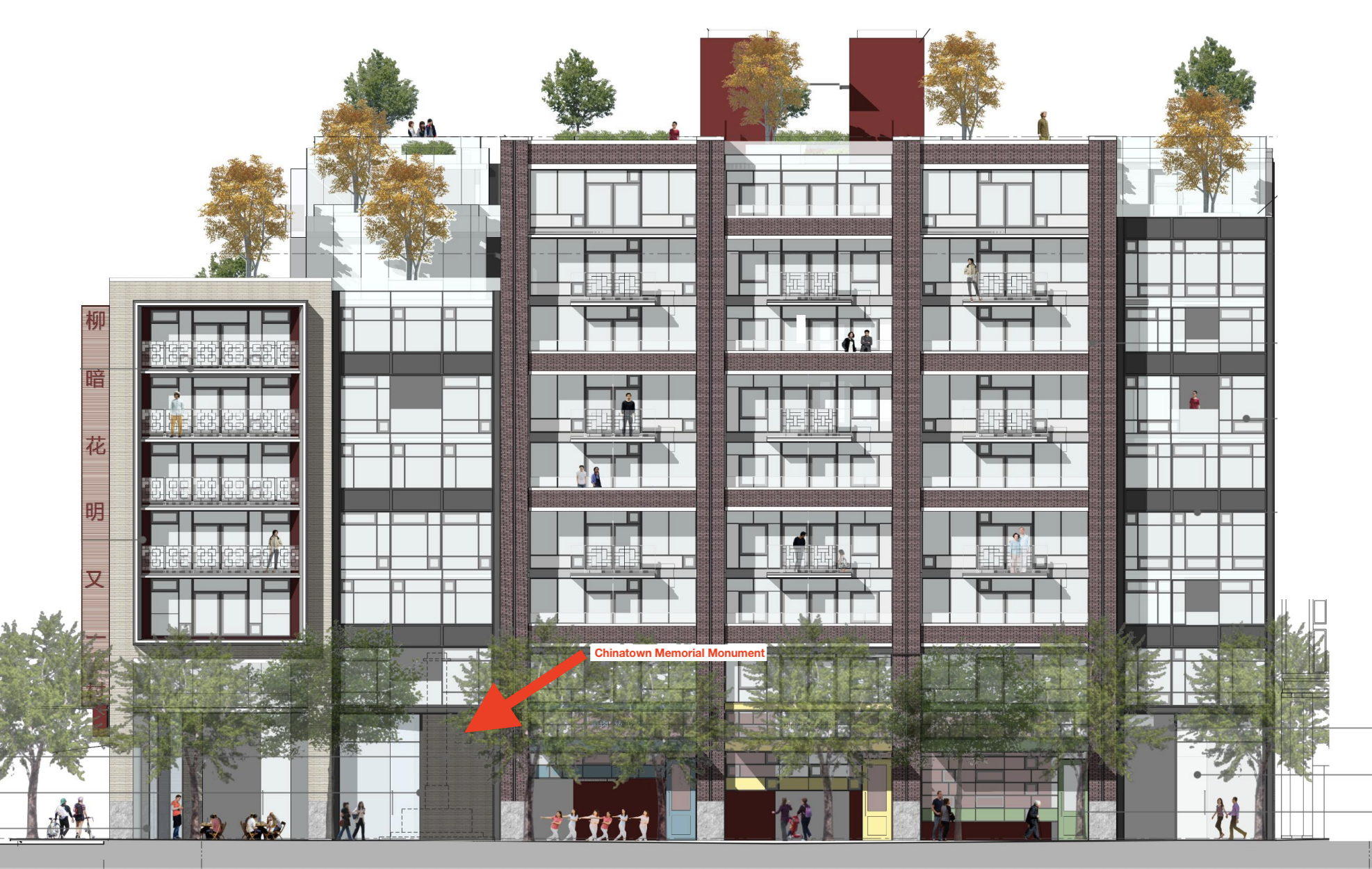Vancouver’s Development Permit Board (DPB) will reconsider Beedie’s proposed luxury condos at 105 Keefer on May 29th. Sign up to speak at the DPB hearing and submit your comments before the hearing. Read our reasons for opposing 105 Keefer below.
Beedie’s 105 Keefer development threatens to accelerate displacement and gentrification in Chinatown, jeopardizing vital cultural spaces and our sense of place in Chinatown. If it goes ahead, 105 Keefer would foreclose the possibility that the site could be used to actually serve the needs of the community in the foreseeable future. This is why it’s so important to oppose Beedie’s application.

Proposed 105 Keefer elevation towering over the Chinatown Memorial Square & Chinatown Memorial Monument. Screenshot from Beedie Living’s Application Documents, prepared by Merrick Architecture, available from the City of Vancouver. Annotated for clarity.
In terms of design, which will be the main focus of the Development Permit Board on May 29th, Beedie’s proposal would negatively affect the site and neighbouring structures, towering over the Chinatown Memorial Square, the Chinatown Memorial Monument, and the Dr. Sun Yat-Sen Park, and is inconsistent with the bylaws, policies, and guidelines for buildings in Chinatown, as the DPB noted in their 2017 decision rejecting 105 Keefer.
In addition to not engaging with the community in the design process, the 9-storey proposal is culturally appropriative at best, featuring tokenistic nods to Chinese culture and vague references to the “spirit of chinatown.”
Beedie seems to suggest that the storefronts directly facing the square should spill out into the adjacent area – not only is the privatization of our public spaces at issue here (the Chinatown Memorial Square shouldn’t be turned into a private front yard for luxury condos and expensive bars), but as Andy Yan pointed out in 2018, opens the door for a whole host of “nightmare scenarios” including the disrespect of the monument to our Chinese-Canadian forebears.
Further, the overwhelming scale of the development and proposed massing of the site would loom over the square, the Chinese-Canadian Military Museum, and the Dr. Sun Yat-Sen Park, the public park next to the Dr. Sun Yat-Sen Classical Chinese Garden. This shows that Beedie failed to meaningfully consider the context of the site, their effects on a vital cultural monument and other significant spaces to the community, and how a development could be designed to be an appropriate response to Chinatown’s unique context.
The Chinatown Memorial Square and the 105 Keefer site stand at one of the gateways to Chinatown. This has been a place for the Chinatown community to come together, build relationships, play mahjong, dance, sing karaoke, and honour our ancestors. Massive luxury condos looming over this site would do irreparable damage to the sense of place in Chinatown.
Across North America, we’ve seen condo gentrification imposed on Chinatowns that, like 105 Keefer, fail to respond to the unique cultural context and needs of Chinatowns, are out of scale, lack character, damage the social fabric of the community and have a chilling effect on the streetscape. This is especially dire when developers are allowed to exploit the gateways and entrances to Chinatowns, where these luxury developments serve to constrict the borders of the neighbourhood, and further the progressive erasure of our communities and living heritage. The damage from this type of gentrification to the sense of place in Chinatowns is apparent in Chinatowns across North America, like in Seattle, Montreal, Los Angeles, Portland, and elsewhere.
Looking at some of the requirements in the design guidelines for the HA-1A District (which encompasses most of Chinatown), it’s clear that Beedie’s proposal is not appropriate for Chinatown. The guidelines aim to discourage large-scale developments at up to 9-storeys like 105 Keefer. Further, the guidelines lay out certain mandatory setback requirements, which Beedie’s design appears not to adhere to. The massing of the building is far too uniform and inconsistent with the objectives of the guidelines to maintain the characteristic “sawtooth” street profile of Chinatown. Another effect of this massing is the negative impact on views. Views, especially public views, are identified as a priority in the guidelines. The diagrams and renderings Beedie submitted in their application use selectively chosen perspectives and viewpoints that downplay the impact on views from the garden, while ignoring the disproportionate impacts on truly public spaces such as the Dr. Sun Yat-Sen Park and Chinatown Memorial Square. This incursion of private interests into the public realm shows a further lack of consideration for the liveability of Chinatown and neighbourliness towards the existing community.
Overall, this demonstrates a design that is not informed by “urbanism”, decreases the livability of Chinatown, and fails to appropriately respond to Chinatown’s established cultural, historical, and design context and identity.
Given the depth and complexity of these design issues, it seems unlikely that they could be addressed through the minor changes that the DPB could mandate in accepting the application with conditions. Many of the required changes would necessitate a dramatic redesign and reduction of floor-space. As such, we recommend that the DPB reject this development outright just like they did in 2017.






